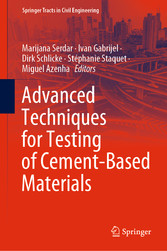Suche
Lesesoftware
Info / Kontakt

Advanced Techniques for Testing of Cement-Based Materials
von: Marijana Serdar, Ivan Gabrijel, Dirk Schlicke, Stéphanie Staquet, Miguel Azenha
Springer-Verlag, 2020
ISBN: 9783030397388 , 246 Seiten
Format: PDF, Online Lesen
Kopierschutz: Wasserzeichen




Preis: 160,49 EUR
eBook anfordern 
Preface
6
Contents
8
1 Acoustic Emission Characterization of Fresh Cement-Based Materials
9
1.1 Introduction
9
1.2 Overview of Acoustic Emission
11
1.3 Related Literature
12
1.4 Discussion
22
1.5 Conclusions
27
References
27
2 Ultrasonic Techniques for Determination and Monitoring Various Properties of Cementitious Materials at Early Ages
31
2.1 Introduction
32
2.2 Ultrasonic Techniques for Measuring Early Age Properties of CBM
33
2.2.1 Theoretical Basics
33
2.2.2 Different Types of Ultrasonic Techniques
53
2.3 Monitoring of CBMs at Early Ages
58
2.3.1 Determination of Different Time Periods Within Structure Formation Process
58
2.3.2 Determination of Setting Process
60
2.3.3 Monitoring of Microstructural Properties
65
2.3.4 Ultrasonic Testing and Early Age Mechanical Properties
66
2.4 Conclusion
70
References
71
3 Elastic Modulus Measurement Through Ambient Response Method
77
3.1 Introduction
77
3.2 EMM-ARM Testing Apparatus
78
3.2.1 Concrete Testing
79
3.2.2 Mortar Testing
79
3.2.3 Cement Paste Testing
79
3.3 Frequency Identification
81
3.3.1 Operational Modal Analysis (OMA)
83
3.3.2 Experimental Modal Analysis (EMA)
85
3.4 E-modulus Estimation
88
3.5 Comparison of EMM-ARM with Other Methods
90
3.5.1 Concrete
90
3.5.2 Cement Paste
93
3.6 Repeatability of E-modulus Estimations
95
3.6.1 Concrete
96
3.6.2 Cement Paste
98
3.7 Accuracy of the E-modulus Estimations
99
3.7.1 Concrete
99
3.7.2 Cement Paste
101
3.8 Conclusions
101
References
102
4 Monitoring the Viscoelastic Behaviour of Cement Based Materials by Means of Repeated Minute-Scale-Duration Loadings
107
4.1 Introduction
107
4.2 Physical Mechanisms of the Basic Creep
109
4.3 Development of a Test Protocol
110
4.3.1 Preliminary Observations Performed on Creep Test of Long Duration
111
4.3.2 Testing Devices
114
4.3.3 Parameters of the Protocol
121
4.4 Results and Data Treatment
123
4.4.1 Data Treatment
124
4.4.2 Impact of the Devices on the Determination of the Elastic and Creep Properties
128
4.4.3 Microstructural Interpretation of the Results
132
4.5 Application of the Repeated Minute-Scale-Duration Loadings
134
4.5.1 Modelling Basic Creep Since Setting Time
134
4.5.2 Identification of Concrete Properties by Means of Multiscale Modelling
135
4.6 Conclusion and Outlook
137
References
137
5 Monitoring of the Thermal and Autogenous Strain
143
5.1 Introduction
144
5.2 Physical Mechanisms
145
5.2.1 Autogenous Deformation
145
5.2.2 Coefficient of Thermal Expansion
148
5.2.3 Correlation Between the Development of the Autogenous Strain and the CTE
151
5.3 Test Setup
152
5.3.1 Cement Paste and Mortar
153
5.3.2 Concrete
154
5.4 Test Protocol and Data Treatment
158
5.4.1 Review of the Literature
158
5.4.2 Development of a New Test Protocol for Concrete
162
5.5 Investigations and Results
169
5.5.1 Sensitivity Analysis on the Determination of the CTE Induced by the Data Processing
169
5.5.2 Extension to Cement Paste and Mortar Scale
174
5.5.3 Correlation Between the Early Development of the CTE and the Autogenous Strain and the Setting
175
5.5.4 Further Recommendation for the Monitoring of the CTE and Autogenous Strain at Very Early Age
176
5.6 Conclusion and Outlook
176
References
177
6 Testing Concrete Since Setting Time Under Free and Restrained Conditions
185
6.1 Introduction
185
6.2 Test Rig Designed for the Study of the Risk of Cracking of Cement Based Materials
189
6.2.1 Passive Restrained Shrinkage Test
189
6.2.2 Active Restrained Shrinkage Test
193
6.3 The TSTM (Temperature Stress Testing Machine)
194
6.3.1 Principle of TSTM’s
194
6.3.2 History of the Development of TSTM’s
195
6.4 Design Testing System
199
6.4.1 Test Setup
199
6.4.2 Test Protocol for the Restrained Shrinkage
205
6.5 Applications
206
6.5.1 Monitoring of the Viscoelastic Properties Since Setting
207
6.5.2 Implementation of Non-destructive Methods on a TSTM Device
207
6.5.3 Testing Concrete in Its Plastic State
208
6.5.4 Influence of Cyclic Loading/Displacement on the Hardening Process of Grout Material
208
6.5.5 Structural Scale
210
6.5.6 Degree of Restraint
210
6.6 Conclusions
211
References
212
7 Adjustable Restraining Frames for Systematic Investigation of Cracking Risk and Crack Formation in Reinforced Concrete Under Restrained Conditions
218
7.1 Introduction
219
7.2 Motivation and Concept
220
7.3 Technical Specification of the Frames
221
7.3.1 General Setup and Functionality
221
7.3.2 Passive Frame for Simulation of Hardening-Induced Stress History
226
7.3.3 Activation of the Frame for Superimposition of Hardening-Induced Stresses with Additional Stresses During Service Life
231
7.3.4 Modified Frame for Investigation of Cracking in Thick Members
233
7.4 Selected Results
236
7.4.1 General Remarks on the Testing Programme Conducted So Far
236
7.4.2 Hardening-Induced Stress History and Risk of Early Age Cracking
237
7.4.3 Superimposition of Hardening-Induced Stressing with Further Imposed Deformations Representative for Service Life
239
7.4.4 Crack Opening During Service Life
240
7.4.5 Evolution of the Restraint Force During Cracking in Thick Members with Reinforcement Near the Surface
241
7.5 Conclusion and Outlook
243
References
244




